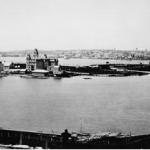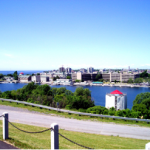Audio: click to listen
Tours : Francophone
Heading : The Royal Military College of Canada
Location Name : RMC
Street Address : 13 General Crerar Crescent
City : Kingston
Short Summary : Although the RMC officially became bilingual in 1976, and the CFB Kingston followed in 1994, the presence of French was historically close to non-existent.
Executive Summary:
The Royal Military College of Canada
Although the RMC officially becomes bilingual in 1976 and the Kingston base follows in 1994, the presence of French remains close to non-existent. We know that at the end of the XIXth century, the future captain Joly de Lotbiniere studied at the college to later become a railroad engineer. Joseph Damase Chartrand (1852-1905) taught French from 1897 until his death. An entire archive file is dedicated to him at the CRCCF. In the 1914 graduation album figure the Captain Jean-Baptiste Octave St-Laurent, Henri de Lotbinière Panet and Henry Vernon. The Major Charles N. Perreau is now staff sergeant at the RMC.
In 1948, with the reopening of the military college after the war, new French speaking professors are hired. Among them, figure a few of the founders of the Club Champlain, including Major Leopold Lamontagne. At the same time, in the regular army, instruction in French is given to low ranking solders. The marine and aviation units progressively follow.
At the military college, among the recuts in 1948, only 12% are francophone. The RMC is only English speaking, while the College Militaire Royal of St John (CMR), founded in 1952 is bilingual.
The success rate of French speakers at CMR is higher than those at RMC. In fact, francophones often complete their first two years at CMR and then transfer to RMC fir their 3rd and 4th year.
The Military College in Kingston Becomes Bilingual
With the policy if bilingualism and biculturalism of 1969, the Canadian forces must adapt progressively. The first measures are imposed at the RMC. A main plan to implement the bilingual and bicultural program is put into action around 1973. However, it is only three years later in 1976 that the RMC/CMR is officially declared bilingual. All the courses must be available in both languages. A large number of professors with a francophone background are recruited, but not all the positions are filled. Classes of French and English as a second language are planned in the new program. In 1978-79, the weeks are alternated in French and English. A language centre that employs thirty instructors is started. The French department has four professors. In 1980-81, 95% of the required courses are offered in French; an exception is made for metallurgy and material structure. Starting in 1986, the students must attain an integral level of bilingualism to graduate. Those who don’t must take language courses before obtaining their diploma and their officer commission.
Period: After 1950
Images:
- Royal Military College of Canada, The Stone Frigate 1914, Kingston, Press of the British Whig, 1914, p. 157, 163, 167.
- Richard A. Preston, Au service du Canada : Histoire du Royal Military College depuis la Deuxième Guerre mondiale, Ottawa, Les Presses de l’Université d’Ottawa, 1992, pp. 174-196.



